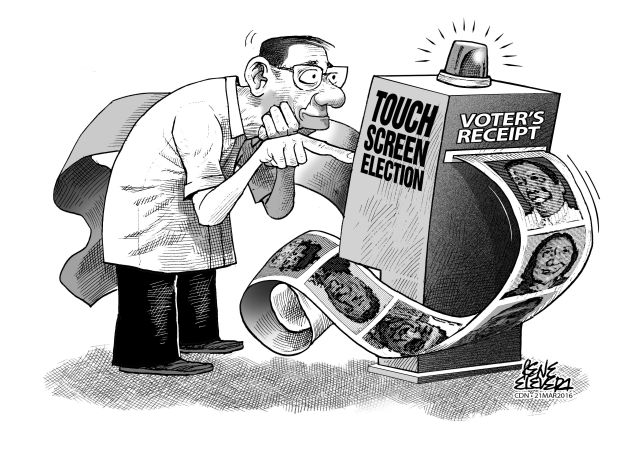
The Supreme Court’s decision to reaffirm its earlier ruling to require the Commission on Elections (Comelec) to issue voters receipts on election day means the poll agency literally has to work double time to revise its preparations days ahead of May 9.
If it had only decided not to reconfigure its SD cards which allowed the automated vote-counting machines to issue voters receipts in the first place, then the Comelec wouldn’t have its problems now.
As it is, we now see the spectacle of the Comelec now bidding out for thousands of scissors and plastic receptacles for the receipts and the Supreme Court saying that it should only print out and give the receipts to voters rather than having to cut them out per voter.
More importantly, the Supreme Court also stood firm in its stance that the Comelec not budge from the scheduled May 9 elections. Congress wasn’t also keen on postponing the elections as Comelec Chairman Andres Bautista had previously warned about after the High Tribunal issued its first ruling on the receipts.
But let’s acknowledge the technical difficulties as Bautista raised in their motion for reconsideration. The Comelec warned that issuance of voters receipts will take more time than usual and that the machines indicating via their screens that they’ve accepted the ballots is proof enough that the votes have been counted.
Last week’s ruling meant the Comelec will have to move the actual voting schedule hours earlier. Bautista said the voting can start as early as 7 a.m. but with their recently signed agreement with the malls, one has to ask if these commercial establishment will agree to extend their business hours beyond their 10 p.m. closing time.
The Comelec chairman warned that the issuance of voters receipts meant that the tabulation of votes will take more than two days. That’s a note of concern but on the other hand, it’s probably a lot better than the alternative of manually counting the votes.
Regardless of what the naysayers said, there is no going back to manual elections. The automated voting and tabulation of votes is still the way to go for the country which had experienced more than its fair share of election protests under the old system.
That said, the next Congress and administration should move towards replacing the automated vote-counting machines with better equipment preferably one used in other countries like the US.
One of the prototypes for the automated vote-counting machines previously proposed was a touch screen model which supposedly contained the photos of the candidates similar to how an ATM machine operates.
One simply had to tap the candidates of his or her choice and the vote is registered for tabulation. But it was rejected for being too pricey. Can it be a viable prospect? It’s up to the Comelec to pursue this and other solutions for the next elections.